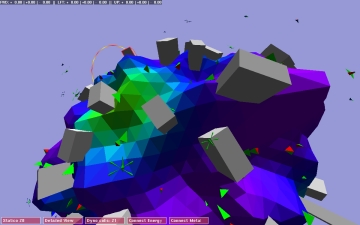Greed Prototype
Greed Prototype is a Real-Time Strategy space and surface resource management, technology development and combat game with multiplayer, multiserver and multiworld support.
Story of Greed
Recently, a number of governments and corporations started to fling fully automated large colonisation mother-ships from Earth into the nearby solar systems where prospective asteroid fields or planets have been discovered. The mother-ships, carrying no human passengers, are using Higgs-field induced worm-holes to get into the target systems, where they retain a quantum control and communication link with their owners on Earth, allowing their commanders (i.e., the players) to exercise control over the mother-ship, its sub-systems and the units it carries.
The first task of a mother-ship is to use its systems to gather more resources, build more units and systems, and establish a foothold for its owners in the new prospective systems. For this reason, the mother-ships are equipped with manufacturing facilities and blueprints for many kinds of systems, including space-ships, ground vehicles, atmospheric vehicles and even new mother-ships and new quantum communication devices.
In theory, these missions were meant to be peaceful research missions, but with the resources in question, and far from human sight, greed came into play. Soon it turned out that accidents are more common when expeditions from different organisations encounter each other in the same system and that many devices can be used in interesting, novel ways. And finally, not all the blueprints the motherships carried with themselves were peaceful in nature ...
Elements of Greed
Players interact with all units via q-comm devices which allow communication between earth and remote systems with no delays. In-system communication is ranged, so a unit that is too far from a q-comm device or is jammed, can not report its sensor data to the player and can not be controlled - its fate depends entirely on its own (AI-provided) decisions, but it can also get lost or be captured. Additionally, a player can construct secondary q-comm devices for additional communication channels and for safeguarding his access, or give a q-comm device to another player. Also, players can share resources and unit control
Of course, if all players q-comm devices are destroyed, he loses control of his game and is essentially finished.
Another resource to think of are the blueprints which permit a player to equip construction facilities for building of specific units and sub-systems. The number of blueprints a mothership can carry is limited, but they can also be captured or discovered from captured units implementing the technology. The knowledge of technology and possession of sub-systems for its implementation is called 'techware' in Greed.
Resorces are implemented as concentrations on surface and unit materials and can be extracted with suitable structures or units. Energy can be generated using fusion, fission or with solar panels. Both matter and energy (or 'juiceware' in Greed parlance) can be stored and transported over short distances using a new technology called Higgs' transfer links (HTL). HTLs connections can be viewed, intercepted and jammed. For transportation of juiceware over longer distances, transporter units have to be used or relay-tower infrastructure built.
Resources come in different types and the most important property is their potential rarity. Some rare resources are necessary for building specific technology and thus acquire strategic importance.
The entities a player can build can be divided in ground units, space units, structures and subsystems that can be installed in units and structures. Some subsystems add abilities to the unit, other behave as an attached subunit and can be controlled independently. Also, bigger units and structures can contain smaller units that can be repaired, retooled or deployed from them.
Further, the entities can be divided according to their use in exploratory/sensor entities, resource entities (such as mining equipment, power generating equipment, resource processing facilities, juiceware containers, transporters, HLT towers, construction units, construction facilities etc.) and military units. Bigger units can, of course, be given combined roles according to subsystems installed.
In every game, the player begins with the mother-ship, a super-unit composed of many sub-systems and containing a number of independent units. The mother-ship is fully equipped to start comes with:
-
a q-comm communication sub-system, allowing for communication with Earth (ie. the player),
-
energy generators and propulsion systems with basic hyper-drive capabilities,
-
basic resource processing, resource routing and fabrication stations,
-
some planetary landers and transporters,
-
some exploration vessels and vehicles,
-
some ground / space construction units.
A mother-ship is a very powerful unit and quite capable of protecting the q-comm initially, but once its units are deployed, it becomes vulnerable to attack. It can also be recycled if the player needs some rare resources that are part of its subsystem or prefers to install the q-come in a different, possibly safer or less obvious location.



